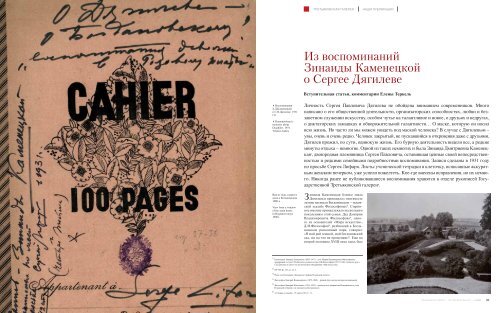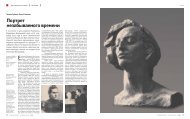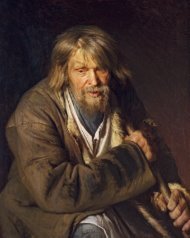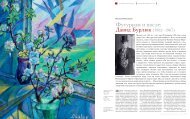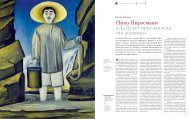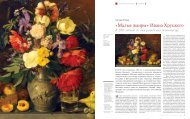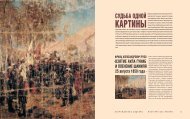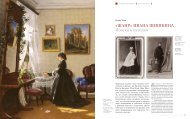Ðз воÑпоминаний ÐÐ¸Ð½Ð°Ð¸Ð´Ñ ÐаменеÑкой о СеÑгее ÐÑгилеве
Ðз воÑпоминаний ÐÐ¸Ð½Ð°Ð¸Ð´Ñ ÐаменеÑкой о СеÑгее ÐÑгилеве
Ðз воÑпоминаний ÐÐ¸Ð½Ð°Ð¸Ð´Ñ ÐаменеÑкой о СеÑгее ÐÑгилеве
You also want an ePaper? Increase the reach of your titles
YUMPU automatically turns print PDFs into web optimized ePapers that Google loves.
ТРЕТЬЯКОВСКАЯ ГАЛЕРЕЯ<br />
НАШИ ПУБЛИКАЦИИ<br />
Из воспоминаний<br />
Зинаиды Каменецкой<br />
о Сергее Дягилеве<br />
Вступительная статья, комментарии Елены Теркель<br />
Воспоминания<br />
З.Д.Каменецкой<br />
о С.П.Дягилеве. 1931<br />
ГТГ<br />
Kamenetskayaʼs<br />
memoirs about<br />
Diaghilev. 1931<br />
Tretyakov Gallery<br />
Вид из окна главного<br />
дома в Богдановском<br />
1900-е<br />
View from a window<br />
of the main house<br />
in Bogdanovskoye<br />
1900s<br />
Личность Сергея Павловича Дягилева не обойдена вниманием современников. Много<br />
написано о его общественной деятельности, организаторских способностях, любви и беззаветном<br />
служении искусству, особом чутье на талантливое и новое, о друзьях и недругах,<br />
о диктаторских замашках и обворожительной галантности… О маске, которую он носил<br />
всю жизнь. Но часто ли мы можем увидеть под маской человека? В случае с Дягилевым –<br />
увы, очень и очень редко. Человек закрытый, не пускавшийся в откровения даже с друзьями,<br />
Дягилев прожил, по сути, одинокую жизнь. Его бурную деятельность видели все, а редкие<br />
минуты отдыха – немногие. Одной из таких немногих и была Зинаида Дмитриевна Каменецкая<br />
1 , двоюродная племянница Сергея Павловича, оставившая ценные своей непосредственностью<br />
и редкими семейными подробностями воспоминания. Записи сделаны в 1931 году<br />
по просьбе Сергея Лифаря. Листы ученической тетрадки в клеточку, исписанные аккуратным<br />
женским почерком, уже успели пожелтеть. Кое-где внесены исправления, но их немного.<br />
Никогда ранее не публиковавшиеся воспоминания хранятся в отделе рукописей Государственной<br />
Третьяковской галереи 2 .<br />
Зинаида Каменецкая близко знала<br />
Дягилева и проводила с ним вместе<br />
летние месяцы в Богдановском – псковской<br />
усадьбе Философовых 3 . Старинное<br />
имение принадлежало нескольким<br />
поколениям этой семьи. Дед Дмитрия<br />
Владимировича Философова 4 , одного<br />
из основателей «Мира искусства»,<br />
Д.Н.Философов 5 , разбивший в Богдановском<br />
роскошный парк, говорил:<br />
«Я мой рай земной, мой богдановский<br />
сад, ни на что не променяю» 6 . Еще во<br />
второй половине XVIII века здесь был<br />
1 Каменецкая Зинаида Дмитриевна (1885–19??) – дочь Марии Владимировны Философовой,<br />
двоюродной сестры С.П.Дягилева, родной сестры Д.В.Философова (1872–1940), близкого друга<br />
С.П.Дягилева и одного из организаторов объединения «Мир искусства».<br />
2 ОР ГТГ, ф. 216, ед. хр. 2.<br />
3 Ныне село Богданово Локнянского района Псковской области.<br />
4 Философов Дмитрий Владимирович (1872–1940) – родной брат матери автора воспоминаний.<br />
5 Философов Дмитрий Николаевич (1784–1822) – предводитель дворянства Новоржевского уезда<br />
Псковской губернии, где находилось Богдановское.<br />
6 «Столица и усадьба». 15 марта 1916. С. 11.<br />
ТРЕТЬЯКОВСКАЯ ГАЛЕРЕЯ / THE TRETYAKOV GALLERY / #3’2009<br />
35
THE TRETYAKOV GALLERY<br />
EXCLUSIVE PUBLICATIONS<br />
НАШИ ПУБЛИКАЦИИ<br />
Дом в Богдановском,<br />
построенный при<br />
А.П.Философовой<br />
в 1870 году. 1900-е<br />
Home in Bogdanovskoye,<br />
built in Anna Filosofovaʼs<br />
lifetime in 1870. 1900s<br />
From the Memoirs<br />
of Zinaida Kamenetskaya<br />
about Sergei Diaghilev<br />
Opening chapter, editing and comments by Yelena Terkel<br />
Sergei Diaghilev enjoyed considerable public exposure during his lifetime. Much has been written<br />
about his public work and management skills, his strong devotion to the arts, his intuitive<br />
ability to spot talent and novelty, his friends and adversaries, his dictatorial manner and allcharming<br />
gallantry – the mask that he always wore. But how often has the reader been able to<br />
penetrate his mask and get a glimpse of the real person behind it? Alas, not too often. An introvert,<br />
avoiding heart to heart conversations even with the closest people, Diaghilev lived an<br />
essentially lonely life. His whirlwind of activity was visible to all, but very few people saw him<br />
in his rare moments of leisure. Zinaida Kamenetskaya 1 , his first cousin once removed, was one<br />
of those few. She left some recollections, full of candour and intimate family details, about her<br />
famous relative. She wrote her memoirs in 1931, after she had been asked to do so by Serge<br />
Lifar. She wrote them down in a school notebook – its pages covered in neat womanʼs handwriting<br />
are now turning slightly yellow. There are some alterations made here and there, but not<br />
too many of them. The memoirs have never been published before and are part of the manuscript<br />
archive of the Tretyakov Gallery 2 .<br />
Zinaida Kamenetskaya knew Diaghilev<br />
very closely; they both often spent the<br />
summer months at Bogdanovskoye, the<br />
Filosofov family estate near Pskov 3 , which<br />
had been a family property for several generations.<br />
D.N. Filosofov 4 (the grandfather<br />
of Dmitry Vladimirovich Filosofov 5 , one of<br />
the founders of the “World of Art” movement)<br />
built a beautiful park there, which he<br />
called “his paradise on earth” and said he<br />
“would not give up for all the money in the<br />
world” 6 . In the second half of the 18th century<br />
the place had been a garden in the style<br />
Анна Петровна<br />
Философова. 1911<br />
Anna Petrovna<br />
Filosofova. 1911<br />
of Versailles; the nearby wood and marshland<br />
had later been turned into an English<br />
park with a lovely pond, which had small<br />
islands and bridges. Venetsianov with his<br />
pupils often visited Bogdanovskoye and<br />
painted a portrait of the lady of the house,<br />
M.М. Filosofova 7 in 1823. In 1825 Alexander<br />
Pushkin visited Bogdanovskoye, where<br />
he listened to Vladimir 8 , the hosts’ fiveyear-old<br />
son, recite a chapter from his<br />
poem “Eugene Onegin”. In 1863 the old<br />
house on the estate burned down. Anna<br />
Filosofova 9 initiated the construction of a<br />
new “dacha” house. The entire family<br />
became involved in its decoration, and<br />
Anna’s daughter Maria 10 wrote in her notes:<br />
“My mother spent 40 summer seasons<br />
nesting and homemaking at her new summer<br />
home. Each spring, she brought with<br />
her a stock of books that she had accumulated<br />
over the winter, and placed them on<br />
the tables for all to read. She was a great<br />
lover of books” 11 .<br />
Known as a public activist, Anna<br />
Filosofova, who in her youth had rebelled<br />
against outdated traditions, in her heart<br />
always associated herself with young people.<br />
“The Russian decadent movement<br />
originated here in Bogdanovskoye, and the<br />
masterminds behind it were my son<br />
Vladimir and my nephew Sergei Diaghilev.<br />
The ‘World of Art’ was conceived here. To<br />
me, a woman of the generation of the<br />
1860s, it all sounded so bizarre that I could<br />
hardly hold back my anger. They used to<br />
laugh at me. No one realised how hard it<br />
was for me to watch the decadent movement<br />
be born before my eyes in my own<br />
house! As any new movement, it was full of<br />
extravagance and excesses. With time, however,<br />
my relationship with them grew less<br />
strained, and I became progressively more<br />
interested in their ideology, many aspects of<br />
which I found extremely appealing. The<br />
atmosphere of falseness finally cleared up,<br />
and while many of the values were made<br />
redundant, the great idea about the search<br />
for and the creation of beauty remained<br />
alive.” 12 . It is no surprise that Bogdanovskoye,<br />
where the lovely surroundings<br />
emphasised the inner beauty of the hosts,<br />
became a source of powerful new ideas<br />
about changing the world, primarily the<br />
world of art.<br />
Zinaida Kamenetskaya describes,<br />
with touching simplicity and understandable<br />
nostalgia, the favourite summer pastimes<br />
of her youth. She, who was a young<br />
girl at the time, paints a vivid picture from<br />
her memory of Diaghilev in those days<br />
that shows an unconventional image of<br />
the man. There is not a trace of awe or<br />
reverence when she reminisces about the<br />
pranks and practical jokes that went on,<br />
interspersing her narrative with comments<br />
about music and literature. At the<br />
time, Diaghilev was still on his way to find<br />
fame and recognition, with his greatest<br />
victories and disappointments still awaiting<br />
him in the future, and his genius yet<br />
uncovered by the world. It is a moment in<br />
his life when he is caught frolicking<br />
youthfully around, a musician and a gambler,<br />
driven by a passionate ambition to be<br />
first in everything, always planning new<br />
tricks and devising new plans – a real-life<br />
personality that we know so well and still<br />
hardly know at all.<br />
About Diaghilev,<br />
about Bogdanovskoye<br />
1 Zinaida Kamenetskaya (1885–19??) – daughter of Maria Filosofova,<br />
cousin of Sergei Diaghilev and sister of Dmitry Filosofov<br />
(1872–1940), a close friend of Diaghilev and one of the founders<br />
of the art group ʻMir Iskusstvaʼ (World of Art).<br />
2 Tretyakov Gallery Manuscript Department, Fund 216, Item 2.;<br />
the memoirs were written in 1931 at the request of Serge Lifar.<br />
3 The estate is currently the village of Bogdanovo, Loknyansky district,<br />
the Pskov region.<br />
4 Filosofov, Dmitry Vladimirovich (1872–1940) was the brother of<br />
the mother of the memoirʼs author.<br />
5 Filosofov, Dmitry Nikolayevich (1784–1822) was the marshal of<br />
nobility of Novorzhevsky Uyezd in the Pskov Gubernia, where<br />
Bogdanovskoye estate was situated.<br />
6 “Stolitsa I Usadba”, 15 March 1916, p. 11.<br />
7 Filosofova, nee Rokotova, Maria Matveyevna was the wife of D.N. Filosofov. The portrait mentioned above is now part of the collection of the State Tretyakov Gallery.<br />
8 Filosofov, Vladimir Dmitrievich (1820-1894) later became well-known as a statesman, a member of the State Council of the Department for Civil and Ecclesiastical Affairs, the<br />
Chief Military Procurator, a full privy councilor, and a state secretary.<br />
9 Filosofova, nee Diaghileva, Anna Pavlovna (1837-1912) was a prominent public figure, an active supporter of the struggle for equality for women, one of the organisers of the first<br />
womenʼs cooperative associations, one of the initiators of the Womenʼs Higher Training Course (the Bestuzhev Course) at S. Petersburg (1878), and the mother of D.V. Filosofov.<br />
10 Kamenetskaya, nee Filosofova, Maria Vladimirovna (1862-?), the elder sister of D.V. Filosofov, was, according to A.N. Benois, “a stately, good-looking, but not very nice lady. She<br />
treated us a bit condescendingly as young boy friends of her “little brother” // Alexander Benois. My Memoirs. In 5 volums. Vol. 2, Moscow., 1990, p. 502.<br />
11 In Commemoration of А.P. Filosofova. Vol. 1, Ptg., 1915, p. 150.<br />
12 Ibid., p. 390.<br />
13 Children of Maria Kamenetskaya (married name Filosofova) – Zinaida and Tatiana Kamenetskaya.<br />
14 The Filosofovs family – Vladimir (1820-1894) and Anna (1837-1912), née Diaghileva.<br />
The “Pink Girls” 13 are still staying with<br />
their grandparents 14 . Letting go of their<br />
adored granddaughters is too hard for the<br />
old folk. It’s late autumn. Rain and wind<br />
often blow through the park, making the<br />
comfort of the old, familiar house at Bogdanovskoye<br />
all the more welcome. The big<br />
ovens in the house are hot, and there is a<br />
fireplace in Grandfather’s office…<br />
The “Pink Girls” were sitting at the<br />
tea-table on both sides of their grandfather,<br />
arguing about which of the two had more<br />
raisins in their piece of pretzel. They were<br />
36 ТРЕТЬЯКОВСКАЯ ГАЛЕРЕЯ / THE TRETYAKOV GALLERY / #3’2009 ТРЕТЬЯКОВСКАЯ ГАЛЕРЕЯ / THE TRETYAKOV GALLERY / #3’2009 37
EXCLUSIVE PUBLICATIONS<br />
НАШИ ПУБЛИКАЦИИ<br />
Г.В.СОРОКА (?)<br />
Интерьер.<br />
Диванная в старом<br />
доме усадьбы<br />
Богдановское. 1840-е<br />
Псковский<br />
музей-заповедник.<br />
Grigory SOROKA (?)<br />
Inside the House.<br />
Lounge in the old house<br />
of the Bogdanovskoye<br />
estate. 1840s<br />
Pskov Museum-Reserve<br />
Аллея в парке <br />
усадьбы Богдановское<br />
1900-е<br />
Alley in the park <br />
of the Bogdanovskoye<br />
estate. 1900-е<br />
15 Dmitry Filosofov (1872-<br />
1940) – brother of the<br />
narratorʼs mother<br />
16 Kamenetskaya Maria<br />
Vladimirovna.<br />
See footprint 10<br />
17 Author of the memoirs<br />
Zinaida Kamenetskaya<br />
picking out the raisins and accurately stacking<br />
them in a small pile pour la bonne<br />
bouche [for dessert (Fr.)]. Everyone raised<br />
their heads to listen as the sound of the<br />
coachman’s whistle, jingle of horse bells,<br />
and the noise of an approaching coach<br />
came from the outside. Another minute<br />
and, still covered with dust from a long<br />
journey, a young man stormed into the dining<br />
room and showered everyone, regardless<br />
of their sex and age, with hugs and kisses.<br />
The “Pink Girls” froze in terror as a pair<br />
of strong hands raised them in the air and<br />
only put them back to sweep their precious<br />
raisins into a mouth which, to them,<br />
appeared to be huge. This was Diaghilev’s<br />
first visit to see the family of his paternal<br />
aunt, Anna Filosofova, and her husband,<br />
the girls’ grandfather, in their ancestral<br />
estate of Bogdanovskoye. Not only did<br />
Diaghilev’s strong, vivid personality leave<br />
an imprint on the lives of every single person<br />
who lived in Bogdanovskoye at the<br />
time, but also the estate itself with its enormous<br />
park (covering 10 arpents), as well as<br />
the whole lifestyle of the highly cultural<br />
Filosofov family gave Diaghilev’s creativity<br />
and growth a powerful boost. Seryozha<br />
adored Bogdanovskoye, as did everyone<br />
who had ever visited it. For many years he<br />
lived there, if but for brief periods of time.<br />
The small grayish house, where all the<br />
young men folk of Bogdanovskoye (the sons<br />
and nephews of Anna Pavlovna, or “Aunt<br />
Nona”) lived, had a separate room for<br />
everyone, and all – including Seryozha –<br />
felt at home there…<br />
Grandmother (“Aunt Nona” or, as<br />
Seryozha called her, “ma tante”) watched<br />
laughingly as the youngsters dragged<br />
pieces of ancient furniture from some dark<br />
corners – things that were dear to her as<br />
memories. It vexed her when Seryozha<br />
teased her about “soup chicken” and<br />
“chicken soup”, or about how the two of<br />
them were so much like each other, which<br />
was to some extent very true. She must<br />
have sensed something deeply powerful<br />
and beautiful in him. She was sneakily<br />
reading his articles and her house was open<br />
to all of Dima 15 and Seryozha’s friends.<br />
After a railroad was finally built three<br />
versts from Bogdanovskoye in the 1900s,<br />
every summer, as a help to Grandmother’s<br />
antique grand piano, Seryozha or his<br />
cousin (the mother of the “Pink Girls”) 16<br />
also brought along their own one. If the<br />
“Pink Girls” had been asked when they<br />
had first heard Wagner or Tchaikovsky<br />
(“Uncle Petya”, as he was called in the<br />
family), they would have been at a loss to<br />
answer because they had known them all<br />
along, and someone or other in the house<br />
was always playing the piano or singing.<br />
Seryozha had a keen interest in singing and<br />
composing at the time. He had a not very<br />
strong, but pleasant, baritone voice but, by<br />
a strange fancy, sang mostly women’s songs<br />
from operas. There was an ongoing mock<br />
‘feud’ between the young men and women<br />
of Bogdanovskoye – no offence was ever<br />
taken, except the one time when Seryozha<br />
was seriously upset by a verse somebody<br />
had written about him, which ended with a<br />
line that said “Lakme is singing, love in his<br />
eyes, and rising on his tiptoes, he carries on<br />
in his little descant voice”.<br />
Everything this family was doing, it<br />
was doing with a lot of passion and fervour.<br />
If a mushroom hunting trip was planned<br />
(great quantities of mushrooms grew in the<br />
park), it always ended in a competition. At<br />
one time, Seryozha kept winning for a<br />
while, until he was caught buying up<br />
mushrooms from some women in the village.<br />
Another cause for passionate fights<br />
was the daily tennis game. The younger of<br />
the “Pink Girls”, Zina 17 , was Seryozha’s<br />
partner. They kept fighting and arguing,<br />
but were inseparable. By five o’clock the<br />
парк в версальском стиле, позднее<br />
близлежащий лес и болотце превратили<br />
в английский парк с чудесным прудом,<br />
островками и мостиками. В Богдановском<br />
не раз бывал с учениками<br />
А.Г.Венецианов, написавший в 1823 году<br />
портрет хозяйки усадьбы – М.М.Философовой<br />
7 . В 1825 году в Богдановском<br />
побывал А.С.Пушкин, которому<br />
сын хозяина, пятилетний Владимир 8 ,<br />
читал наизусть главу из «Евгения Онегина».<br />
В 1863 году усадебный дом сгорел.<br />
Анна Павловна Философова 9 затеяла<br />
строительство нового дома-дачи.<br />
В отделке дома участвовало все семейство,<br />
о чем оставила записи дочь А.П.Философовой<br />
Мария 10 : «В этом своем доме<br />
мама прожила 40 летних сезонов,<br />
обживая его и придавая уют. Она весной<br />
привозила большой запас книг, накопившийся<br />
за зиму, и раскладывала их<br />
по столам на общее пользование. Книги<br />
она очень любила» 11 . Известная общественная<br />
деятельница, Анна Павловна<br />
сама в молодости боровшаяся с засильем<br />
традиционных взглядов, сердцем<br />
всегда была с молодежью: «Русское<br />
декадентство родилось у нас в Богдановском,<br />
потому что главными заправилами<br />
были мой сын Владимир Дмитриевич<br />
и мой племянник С.П.Дягилев.<br />
"Мир искусства" зачался у нас. Для<br />
меня, женщины 60-х годов, все это было<br />
так дико, что я с трудом сдерживала<br />
мое негодование. Они надо мной смеялись.<br />
Все поймут, какие тяжкие минуты<br />
я переживала при рождении декадентства<br />
у меня в доме! Как всякое<br />
новое движение оно было полно тогда<br />
экстравагантностей и эксцессов. Тем не<br />
менее, когда прошла острота отношений,<br />
я заинтересовалась их мировоззрением<br />
и должна сказать откровенно,<br />
что многое меня захватило. Ложная атмосфера<br />
очистилась, многое сдано в архив,<br />
а осталась несомненною одна великая<br />
идея, которая искала и рождала<br />
красоту» 12 . Неудивительно, что в Богдановском,<br />
легко рождались новые идеи<br />
по переустройству мира, мира искусства.<br />
Зинаида Каменецкая описывает<br />
летнее времяпровождение молодежи<br />
в Богдановском с трогательной простотой<br />
и естественной ностальгией. Девочке<br />
запомнилось несколько ярких картин,<br />
в которых Сергей Дягилев предстает<br />
перед нами с неожиданной стороны.<br />
Без пиетета и придыхания пишет Зинаида<br />
Дмитриевна о шалостях и розыгрышах,<br />
а между делом – о музыке и литературе.<br />
Сергей Павлович еще не добился<br />
всемирного признания, его ждут победы<br />
и поражения, впереди великая слава…<br />
А пока перед нами встает образ веселого<br />
озорника и музыканта, азартного игрока,<br />
во что бы то ни стало желавшего<br />
быть первым, вечного выдумщика и фантазера,<br />
а может, просто живого человека,<br />
о котором мы так много и одновременно<br />
так мало знаем.<br />
О Дягилеве, о Богдановском<br />
Розовые девочки 13 все еще гостят у дедушки<br />
с бабушкой 14 Старикам жаль расставаться<br />
с любимыми внучками. Глубокая<br />
осень. Ветер и дождь часто шумят<br />
в парке. И тем уютнее в старом родном<br />
Богдановском доме. Топят большие печи,<br />
а у дедушки в кабинете – камин…<br />
Розовые девочки, сидя по обеим<br />
сторонам дедушки, за большим чайным<br />
столом сорились – у кого больше изюминок<br />
в куске кренделя. Изюминки выковыривались<br />
и тщательно складывались<br />
в кучку pour la bonne bouche на закуску<br />
(фр.)]. Все с интересом подняли<br />
голову – у крыльца послышался свист<br />
7 Философова (урожденная Рокотова) Мария Матвеевна – жена Д.Н.Философова. Упоминаемый<br />
портрет находится в собрании ГТГ.<br />
8 Философов Владимир Дмитриевич (1820–1894) – известный государственный деятель, член<br />
Государственного совета Российской империи по департаменту гражданских и духовных дел,<br />
главный военный прокурор, действительный тайный советник, статс-секретарь.<br />
9 Философова (урожденная Дягилева) Анна Павловна (1837–1912) – выдающийся общественный<br />
деятель, активная участница борьбы за равноправие женщин, одна из организаторов первых<br />
женских артелей, одна из инициаторов создания Высших женских (Бестужевских) курсов<br />
в Санкт-Петербурге (1878), мать Д.В.Философова.<br />
10 Каменецкая (урожденная Философова) Мария Владимировна (1862–?) – старшая сестра<br />
Д.В.Философова. По словам А.Н.Бенуа, «была статной, красивой, но не очень симпатичной дамой.<br />
К нам она относилась чуть свысока – как к мальчишкам, друзьям ее «маленького» брата»<br />
(Александр Бенуа. Мои воспоминания. В 5 кн. Кн. 2. М., 1990. С. 502.<br />
11 Сб. памяти Анны Павловны Философовой. Т. 1. Птг., 1915. С. 150.<br />
12 Там же, с. 390.<br />
13 Имеются в виду дети Марии Владимировны Каменецкой (урожденной Философовой) – Зинаида<br />
и Татьяна Каменецкие.<br />
14 Имеется в виду семья Философовых Владимира Дмитриевича и Анны Павловны.<br />
38 ТРЕТЬЯКОВСКАЯ ГАЛЕРЕЯ / THE TRETYAKOV GALLERY / #3’2009<br />
ТРЕТЬЯКОВСКАЯ ГАЛЕРЕЯ / THE TRETYAKOV GALLERY / #3’2009<br />
39
EXCLUSIVE PUBLICATIONS<br />
НАШИ ПУБЛИКАЦИИ<br />
Парадный въезд<br />
в усадьбу<br />
Богдановское.<br />
Рисунок из книги<br />
«Памяти А.П.Философовой».<br />
Птг., 1915<br />
Пруд в Богдановском<br />
Фотография<br />
Елены Теркель. 2009<br />
Pond in Bogdanovskoye<br />
Photograph by<br />
Yelena Terkel. 2009<br />
Front gate in the<br />
Bogdanovskoye estate.<br />
Drawing from the<br />
book “In memoriam<br />
of Anna Filosofova”.<br />
Petrograd, 1915<br />
older folk gathered at a tennis court under<br />
age-old linden trees to see the youngsters<br />
play. Sometimes when it was too hot, Seryozha<br />
would break down and start taking off<br />
items of his clothing, booming out to the<br />
“Pink Girls’” mother, “Manichka, I swear<br />
I won’t take off anything else!”…<br />
It is steamily hot. A boat is floating<br />
on the dark-watered lake. Seryozha is lying<br />
in the bottom of the boat, proofing an article<br />
for his column in the “World of Art”<br />
magazine. Dima and the “Pink Girls” are<br />
sitting on the boat’s benches, reading. The<br />
air is full of the smells of linden blossom<br />
and river mud. Seryozha is feeling too lazy<br />
to move or think. Closing his papers, he<br />
quietly picks up an oar and slaps the water<br />
with it. The girls, wet from the spray of<br />
water, are up on their feet in a panic. The<br />
ancient boat is tilting and turning around.<br />
Now it is Seryozha’s turn to cry out in fear<br />
– a clairvoyant, living with her dogs and<br />
cats midway between Bogdanovskoye and<br />
Usadishe, predicted that he would “die by<br />
water”.<br />
Strange as it may seem, in many<br />
years’ time her prediction turned out to be<br />
true 18 .<br />
18 Diaghilev died in Venice on August 19 1929 having a rest by the<br />
water.<br />
Пруд <br />
в Богдановском<br />
Рисунок из книги<br />
«Памяти<br />
А.П.Философовой».<br />
Птг., 1915<br />
Pond <br />
in Bogdanovskoye.<br />
Drawing from the book<br />
“In memoriam of Anna<br />
Filosofova”.<br />
Petrograd, 1915<br />
Омшаник в селе<br />
Богдановское.<br />
Рисунок из книги<br />
«Памяти<br />
А.П.Философовой».<br />
Птг., 1915<br />
Beehouse<br />
in Bogdanovskoye<br />
village.<br />
Drawing from the<br />
book “In memoriam<br />
of Anna Filosofova”.<br />
Petrograd, 1915<br />
15 Философов Д.В. Cм.<br />
сноску 5.<br />
16 Каменецкая М.В. Cм.<br />
сноску 10.<br />
17 Автор воспоминаний –<br />
З.Д.Каменецкая.<br />
18 С.П.Дягилев умер<br />
19 августа 1929 года<br />
в Венеции, куда приехал<br />
отдыхать на воды.<br />
ямщика, колокольчики и звук подъехавшей<br />
перекладной. А через минуту еще<br />
весь пыльный от далекой дороги ворвался<br />
в столовую какой-то молодой человек<br />
и начал без разбора пола и возраста<br />
всех целовать и обнимать! Розовые<br />
девочки с ужасом почувствовали, как их<br />
подняли на воздух сильные руки и оставили<br />
в покое, только чтобы засунуть<br />
в огромную, как им казалось, пасть любимые<br />
изюминки. Это было первое появление<br />
в семье своей тетки по отцу,<br />
А.П.Философовой, и ее мужа, дедушки<br />
розовых девочек, С.П.Дягилева, в родовом<br />
селе семьи Философовых – Богдановском.<br />
Если на всех обитателей Богдановского<br />
яркая и сильная личность<br />
С[ергея] Д[ягилева] оставила след на всю<br />
жизнь, то и село Богдановское с его огромным<br />
парком (парк на 30 десятинах)<br />
с бытом и укладом необыкновенно культурной<br />
семьи Вл. Дм. Философова – дало<br />
бесконечно много С[ергею] Д[ягилеву],<br />
помогло его росту и расцвету. Сережа<br />
Богдановское обожал, как и все,<br />
кто там бывал. Много лет, хоть не на<br />
долго, он там жил. В сереньком домике,<br />
где жила вся мужская молодежь села<br />
Бог[дановское], сыновья и племянники<br />
Анны Павл[овны], «тети Ноны»,<br />
у каждого была раз и навсегда своя комната,<br />
и каждый, в том числе и Сережа,<br />
был у себя дома…<br />
Бабушка – «тетя Нона» или «ma<br />
tante», по-Сережиному, – со смехом<br />
смотрела, как из разных закоулков молодежь<br />
вытаскивала старинную мебель,<br />
дорогую ей только по воспоминаниям…<br />
Ее сердило, когда Сережа ее дразнил<br />
курицей из супа и супом из курицы для<br />
всех, и тем, что они оба так похожи друг<br />
на друга, в чем он был по-своему прав.<br />
И все-таки она чувствовала в нем что-то<br />
и сильное, и прекрасное. Она потихоньку<br />
читала его статьи и стала принимать<br />
всех друзей Димы 15 и Сережи.<br />
Когда наконец в 1900 годах провели<br />
в трех верстах от Богдановского<br />
железную дорогу, каждое лето или Сережа,<br />
или его кузина, мать розовых девочек<br />
16 , привозили в подмогу старинному<br />
роялю бабушки свой инструмент.<br />
И если бы спросили роз[овых] девочек,<br />
когда они в первый раз услыхали<br />
Вагнера или Чайковского (дядю Петю,<br />
как его звали в семье), они затруднились<br />
бы ответить; они их знали всегда,<br />
целый день кто-то в доме играл, кто-то<br />
пел. Сережа тогда увлекался композиторством<br />
и пением. У него был не сильный,<br />
но приятный баритон, но, по<br />
странной фантазии, он пел много женских<br />
арий. Между женской и мужской<br />
молодежью села Богд[ановское] шла<br />
вечная шуточная война, конечно, без<br />
обид, и единственный раз, когда Сережа<br />
серьезно обиделся, – это были стихи<br />
на него написанные, кончавшиеся словами<br />
«поет Лакме, любовь и очи, и, приподнявшись<br />
на носочках, он все выводит<br />
дисканточком». В этой семье все<br />
делалось с жаром, с азартом. Искались<br />
ли грибы, а их была бездна в парке, сейчас<br />
же начиналась конкуренция. Одно<br />
время победителем был Сережа, пока<br />
не был уличен – он скупал грибы у баб.<br />
Каждый день шла не менее страстная<br />
игра в теннис. Младшая розовая девочка<br />
– Зина 17 – была партнершей Сережи.<br />
Они ссорились, ругались и были неразлучны.<br />
Часам к 5-ти на теннис – он<br />
был расположен под огромными вековыми<br />
липами – сходились старшие смотреть<br />
на игру. Если было жарко, С[ережа]<br />
не выдерживал и начинал понемногу<br />
раздеваться, крича матери розовых<br />
девочек: «Маничка, клянусь – больше<br />
ничего не сниму»…<br />
Парит. На темном озере тихо стоит<br />
лодка. На дне лежит Сережа и исправляет<br />
очередную статью для «Мира Иск[усства]».<br />
На лавочках сидят Дима и роз[овые]<br />
девочки и читают. Пахнет цветущей<br />
липой, тиной. Сереже лень двигаться,<br />
лень думать. Закрыв свои бумаги, он потихоньку<br />
берет весло и ударяет по воде.<br />
Дима и девочки, залитые брызгами, испуганно<br />
вскакивают со своих мест. Утлая<br />
лодка начинает крениться и вертеться.<br />
Но тут уже орет от страха Сережа –<br />
гадалка Блоха, та, что живет между Богд[ановским]<br />
и Усадищем со своими кошками<br />
и собаками, – предсказала ему<br />
«смерть на воде». И, как ни странно, через<br />
много лет предсказание сбылось 18 .<br />
40 ТРЕТЬЯКОВСКАЯ ГАЛЕРЕЯ / THE TRETYAKOV GALLERY / #3’2009<br />
ТРЕТЬЯКОВСКАЯ ГАЛЕРЕЯ / THE TRETYAKOV GALLERY / #3’2009<br />
41


